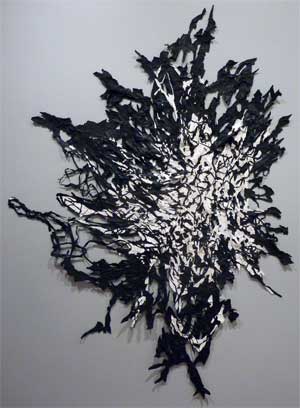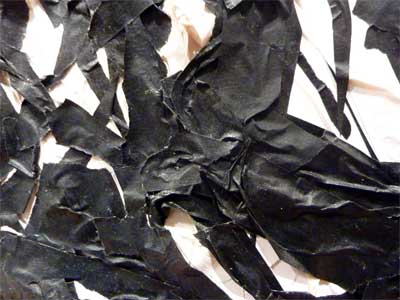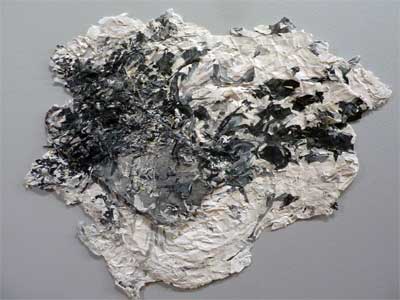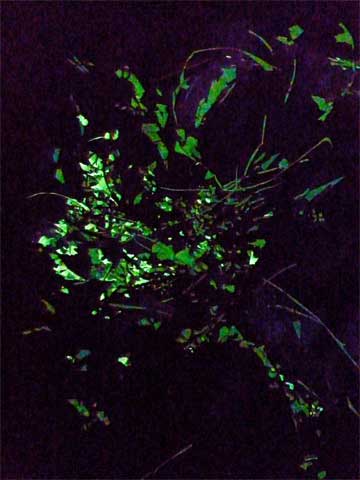Gallery Kayafas
Boston, MA
October 22 – November 26, 2011

Debra Weisberg
Looking a bit like paintings by Jackson Pollock at the outset, there is something generally explosive about them.
They are all works made out of cut tape, but they can be quite different from one another. It is amazing how many different forms Weisberg generates. Clearly her improvisations take her in varied directions, some more sculptural, others more painterly.

Weisberg indicated in conversation that much of her work is about rupture; a good number of the pieces in this show started with a simple rectangle which she then began to operate upon in this improvisational mode she suggests is disruptive of the original discrete form. This approach follows upon past work; (Sub)Surface (2004), displayed at the deCordova Museum a number of years ago, was a thirty foot tall sculpture, seemingly of a piece with a vertical wall that at its peak bulged and appeared to open a hole.
There is enormous energy in her work, and frequently a seeming force that sends lines out from an apparent center. This differentiates it from the motivation of many of Pollock’s works, expressive of kinetically potent, but decentralized, energy. Weisberg’s work, in this way, offers more of a galactic sense, evoking a feeling of pressure outwards from a gravitational core. Pollock’s energy is more dancelike: rhythmic and intoxicating, but not specifically recalling a point of origin.

Included in the exhibition was a series of smaller works that glowed in the dark. The show was set up so that one first had the opportunity to see them in the light and then again with the lights turned off. That duality presented a curious dialogue between the visibly writhing forms etched in dark lines, and the much more sedate (and, as Weisberg puts it – cosmic) feel of glowing with the lights out.

An aesthetic curiosity of astronomical events is the contrast between the cosmic force with which they are created and, in the silence and great distance of space, their timeless quietude. Weisberg’s work interestingly exhibits this duality. One gets two works for the price of one here, gaining the curious sensation of explosiveness and rupture call forth and reverberate. From a different stance, with a different form of illumination, the turbulent thrust of one set of images calls forth their quietly reflective, glowing twins.
Judy Haberl
Images of Antidote from Cate McQuaid’s blog
Antidote, a large photo reconstruction of many singular images taken from the Green Animals Topiary Garden in Portsmouth, RI, was also in the glow gallery.
By themselves, the topiary figures are very cool – just seeing Antidote inspired me to go to Portsmouth. There is also something densely reassuring about Haberl’s edited compacting of the images. Like a silent vigil depicting a long history, it has a bit of the epic sweep of Gauguin’s Where Do We Come From? What Are We? Where Are We Going? but with a more contemporary, strongly ecological, feel. Its glow-in-the-dark feature provides the sense that these bush-creatures have a second life once we turn the glare from them. The garden they inhabit becomes, in this second light, more their own and less ours, yielding a sense of subtle habitat rather than manufactured construction.
(For a different artist’s work with animal imagery that calls to mind this Gauguin masterpiece in some ways, check out Kathi Packer’s Rats.)
In the rhythm of light and dark of the glow room, Antidote is a nice, terrestrial and ecological counterpart to Weisberg’s cosmic swirls and quietly echoing caverns of space.
I am not sure, upon reflection, whether Dystopian Dreaming gets at what these artists convey. “Dystopia” refers, typically, to a warped and distressing version of the future à la Brave New World.
These images, alternatively, are quietly reassuring. If anything, they are vivid and compelling dreams that assuage the alienation of dystopian theats, which is, perhaps, what the name wants to offer. In addition to delivering images that are cool to see, glowing in the darkness provides a reassuring metaphor.
– BADMan
Leave a Reply